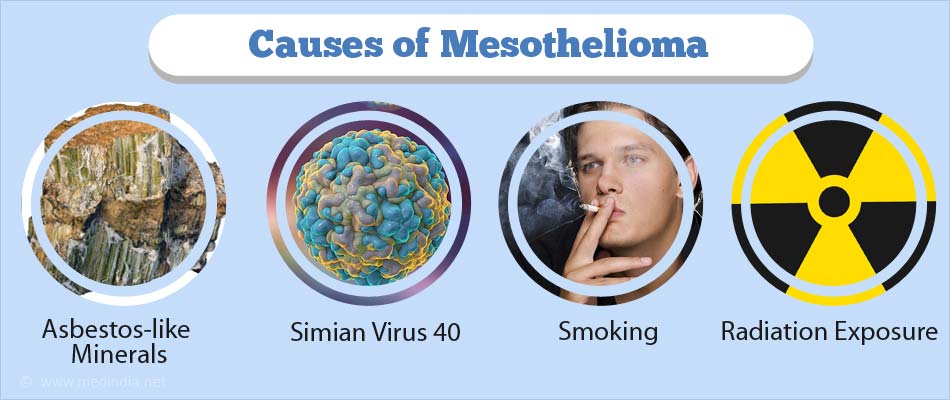What is Mesothelioma?
Mesothelioma is a type of rare cancer that develops in the mesothelium-a thin layer of tissue that surrounds many of the internal organs such as the lungs, heart and testis. A cancerous tumor of the mesothelium is called a malignant mesothelioma, but is generally referred to as mesothelioma. It is an aggressive form of cancer.
More than 80% of mesothelioma cases are caused by exposure to asbestos. Exposure to asbestos leads to asbestosis, a chronic respiratory disease where the inhaled asbestos fibers cause lung scarring and stiffness of the lungs. Asbestosis prevents the patients from taking full and deep breaths. It is not a cancer but the patients with asbestosis more likely develop lung cancer and mesothelioma. Asbestosis develops from the lodging of asbestos fibers in the alveoli / air sacs of the lungs whereas mesothelioma develops from the asbestos fibers lodged in the lining of the lungs.
According to the National Asbestos Profile of India by The Occupational and Environmental Health Network of India (OEHNI) published on April 28, 2017, fifty five countries have banned the use, trade, import, mining, manufacturing and other economic activities related to asbestos. In spite of adequate evidence about the role of asbestos in mesothelioma, India is one of world’s largest importers of asbestos. In 2014-15, India has imported over 396,493 tons and by 2017, it is expected to rise by 605,000 tons with 9% growth. During 2009-2012, 21 cases of mesothelioma were reported at the Gujarat Cancer Research Institute, Ahmedabad while in 2013, in just one year, 23 cases of mesothelioma were diagnosed.
What are the Types of Mesothelioma?
Mesothelioma can be divided into different types on the basis of its location, types of cells involved and the presence of malignancy.
a) Mesothelioma type by location: The most common way to classify mesothelioma is based on the location of the cancer.
- Pleural mesothelioma– This is the most common type and develops in the lining of the lungs (known as the pleura). It is hard to diagnose.
- Peritoneal Mesothelioma-It originates in the lining of the abdomen and often spreads to abdominal organs, including the spleen, liver and bowel.
- Pericardial Mesothelioma– It is rare (less than 1%) and originates in the lining of heart (the pericardium).
- Testicular Mesothelioma-It is an extremely rare form of the disease, with less than 100 cases having been diagnosed around the world.
b) On the basis of cell types:
- Epithelial mesothelioma- It is the most prevalent type responsible for approximately 75% of diagnosed cases. The cells are uniform in shape with an elongated pattern. Epithelial mesotheliomas have the best outcomes.
- Sarcomatoid mesothelioma– It is a less common type of mesothelioma and the cells are long, spindle-shaped, arranged in a haphazard way and grow out of supportive structures, such as bones and muscles.
- Biphasic / Mixed mesothelioma– It consists of a mix of epithelial and sarcomatoid cell types.
- Malignant Mesothelioma– Most forms of mesothelioma are malignant, making the disease, as a whole, very deadly.
- Benign Mesothelioma– It is very rare and well-differentiated papillary mesothelioma (WDPM) is one of the examples of benign mesothelioma.
What is New in Mesothelioma?
1. Mesothelioma: Combining Two Immunotherapy Drugs can Improve Survival
Combining two cancer immunotherapy drugs help improve survival in patients who have aggressive cancer malignant mesothelioma, reveals a new study. The two cancer immunotherapy drugs include a novel immune modulator, plus one that focuses and activates the antitumor immune response. Read More..
What are the Causes of Mesothelioma?
Generally, when asbestos fibers are inhaled, they get lodged in the lining of the lungs or the heart. They enter the abdomen when they are cough up from the lungs and swallowed. They cause inflammation that finally leads to the development of mesothelioma.
Asbestos is a generic name for six types of silicate minerals that share common properties. Asbestos can cause DNA damage both directly as well as indirectly. Asbestos impedes the process of mitotic cell division leading to cellular damage and mutation. Further, asbestos also causes mesothelial cells to release reactive oxygen and nitrogen species, the agents that also cause mutation.
Usually, it takes 10-50 years for mesothelioma to develop after the asbestos exposure. This is one of the reasons why mesothelioma cases continue to appear in the countries even where asbestos has been banned. However, in few cases, the latency period is quite shorter and this is supported by the findings of mesothelioma in children and young teenagers.
In 80% of the cases, asbestos exposure is the cause of mesothelioma. However, recent studies have shown the role of certain environmental risk factors contributing to mesothelioma symptoms. In 2016, the case of a 60-year-old patient with mesothelioma without any prior exposure to asbestos has been reported.
- Asbestos-like minerals: Other silicate minerals such as Erionite, a form of zeolite, in particular has been associated with mesothelioma.
- Simian Virus 40 (SV40): A number of studies have reported association of SV40 with mesothelioma leading to the speculation that SV40 may contribute to the development of mesothelioma, though it does not appear to cause mesothelioma on its own.
- Smoking: Individuals who smoke and are exposed to asbestos are at a much higher risk.
- Radiation Exposure: In few cases, mesothelioma is caused by radiation exposure.
- Carbon Nanotubes: Some researchers have reported carbon nanotubes, and other high aspect ratio nanoparticles (HARNs), as potential causes of mesothelioma.

What are the Symptoms of Mesothelioma?
In its early stages, mesothelioma does not have many symptoms. Most of the symptoms are caused by the growing cancer and the pressure it exerts on a nerve or other body organ.
The symptoms of pleural mesothelioma are persistent cough, tiredness, chest pain, loss of appetite, shortness of breath, sweating and high temperatures, losing weight, difficulty in swallowing, a hoarse or husky voice, and in some cases, changes in the shape of the fingers and nails (known as finger clubbing).
The symptoms of peritoneal mesothelioma are abdominal swelling, lumps in the abdomen, pain in the abdomen, poor appetite, diarrhea or constipation and unexplained weight loss.
Patients suffering from pericardial mesothelioma experience difficulty in breathing and chest pain whereas mesothelioma of testis can be first detected as swelling or a mass on a testicle.

How do you Diagnose Mesothelioma?
Patients with the above symptoms should visit a doctor. The diagnostic tests consist of imaging tests, blood tests and biopsies.
Imaging tests: Usually the first step in making a mesothelioma diagnosis involves X-ray imaging. X-rays detect fluid accumulation caused by the mesothelioma. CT scan is more conclusive than x-rays as CT scans can determine the location of tumors allowing doctors to take a biopsy and make a definite diagnosis. Mesothelioma cells appear as bright spots on a PET scan making this scan useful to determine the extent of spread of the cancer to other sites. An MRI scan is useful to determine the damage to tissue surrounding the tumor and in diagnosing peritoneal mesothelioma.
Blood tests: These tests look for the presence of biomarkers which are found to be elevated in people with mesothelioma. The biomarkers that may be measured include:
- Soluble mesothelin related peptides (SMRP)
- Megakaryocyte potentiation factor (MPF), which is produced by a mesothelin precursor protein
- Cancer Antigen 125 (CA125)
- Fibulin-3. Although it is still in the early testing stages, this promising new biomarker could serve as an early warning in patients with mesothelioma. Fibulin-3 is a protein found in plasma which indicates the presence of mesothelioma.
In addition, the measurement of biomarkers such as osteopontin, interleukin-6 (IL-6), mesothelin, 8-hydroxy-2′-deoxyguanosine (8OHdG), vascular endothelial growth factor-beta (VEGF-β), and estrogen receptor beta (ERβ) also have proven to be useful in detecting mesothelioma or monitoring the effectiveness of treatment.
Biopsies: These tests can reveal whether a growth is cancerous, where in the body the cancer originated and what type of cells are involved. There are several ways by which biopsies are performed such as fine-needle aspiration, incisional/core and excisional biopsy. The biopsy may be performed through procedures like a thoracoscopy or a mediastinoscopy.
Immunohistochemistry: The presence of markers such as calretinin, podoplanin (PDPN), EMA (epithelial membrane antigen) in a membranous distribution, mesothelin, WT1 (Wilms’ tumour 1), cytokeratin, HBME-1 (Human mesothelial cell), or osteopontin in the biopsy sample could suggest the presence of mesothelioma.
The analysis of pleural fluid is usually not useful in the diagnosis of mesothelioma.
Staging of mesothelioma is based on the recommendation by the International Mesothelioma Interest Group and is staged I–IV based on the TNM status.
How do you Treat Mesothelioma?
It is quite challenging to treat mesothelioma patients. The important factors determining a mesothelioma treatment plan include the primary site affected, the cell type of the cancer, whether the cancer is localized to the chest or has spread to the chest wall, diaphragm, or lymph nodes, as well as the age and overall health of the patient.
The approaches currently used for the treatment are chemotherapy, and multimodal treatment. Multimodal treatment generally consists of a primary treatment (surgery to remove the tumor) used in combination with a neoadjuvant therapy (radiation to shrink the tumor size) and an adjuvant treatment (chemotherapy to kill any remaining cells). In various studies, multimodal treatment has been shown to be more effective than any of the individual treatments alone.
Surgery: For patients with an early-stage mesothelioma diagnosis, surgery can be used to remove the mesothelial lining, one or more lymph nodes, or part or all of a lung or other organ. Sometimes, it works as palliative as it relieves the symptoms of mesothelioma, without aggressively treating the disease. In pleurectomy / decortication, the pleura is removed along with the cancers, while in extrapleural pneumonectomy, the lung and pleura are removed along with other affected parts.
Radiotherapy: The efficacy of this treatment is limited as irradiation with a high radiation dose to an extensive tumor area can cause severe adverse effects such as pneumonitis, myocarditis, and myelopathy due to spinal cord toxicity. It is therefore mostly used for palliative purposes or in combination with surgery.
Photodynamic (PDT) therapy: It is a light-based cancer treatment which requires the interaction of a photosensitizer, oxygen, and light and these three together induce a tumoricidal photochemical reaction. Recently, it was shown that PDT offers an improved survival but it has to be confirmed by a randomized clinical trial.
Chemotherapy: Cisplatin and pemetrexed, an antifolate combination chemotherapy are the current preferred treatment for mesothelioma. Gemcitabine can be combined with pemetrexed in patients who cannot take cisplatin. Other combinations that have been tried out include cisplatin/doxorubicin/mitomycin C, bleomycin/intrapleural hyaluronidase, cisplatin/doxorubicin, carboplatin/gemcitabine, and cisplatin/vinblastine/mitomycin C.

Immunotherapy: This type of treatment is more specific and targeted than the chemotherapy and spurs the patient’s own defenses to fight the cancer.
Recently, it was observed that two young women with papillary peritoneal mesothelioma with widespread recurrence received platinum-pemetrexed chemotherapy along with apitolisib, a dual phosphoinositide 3-kinase-mammalian target of rapamycin (PI3K-mTOR) inhibitor. Both the patients are alive and well 10–13 years after the diagnosis. This study identifies the use of targeted therapies with PI3K-mTOR-based inhibitors as a novel approach, warranting further clinical assessment.
Other immunotherapy drugs that show promise in the treatment of mesothelioma are pembrolizumab, tremelimumab, bevacizumab and atezolizumab.
How do you Prevent Mesothelioma?
As mesothelioma is caused by exposure to asbestos, reducing the exposure to asbestos can prevent mesothelioma. The people working in the places where asbestos is used should follow employer’s safety precautions.
What is the Prognosis for Mesothelioma?
The prognosis for mesothelioma is quite poor, with majority of patients living less than 1 year after the diagnosis is made. Based on data from the National Cancer Institute’s SEER program, the relative 5-year survival rate for mesothelioma is 5-10%. People diagnosed at a younger age tend to survive longer. The prognosis can be improved by starting treatment as soon as the diagnosis is made and leading a healthy lifestyle.
The Median Life Expectancy based on the stage for pleural mesothelioma patients is 21 months for stage I, 19 months for stage II, 16 months for stage III and 12 months for stage IV.
Some factors affect the prognosis such as:
- Age: The prognosis is always better for younger patients as their bodies can handle the treatment in a better way.
- Gender: Women with pleural mesothelioma typically have a better prognosis than men due to the hormonal differences.
- Blood characteristics: Certain biomarkers present in the blood may influence the prognosis. High levels of the protein COX-2 can indicate a longer life expectancy.
- Cell types: Epithelioid cells stick together very closely and do not spread easily, so, mesothelioma of the epithelial cell type carries the best prognosis.
- Location: Peritoneal mesothelioma has a slightly better prognosis than pleural mesothelioma, while pericardial mesothelioma has a very poor prognosis.
- Stage: Mesothelioma patients diagnosed at an early stage will have a better prognosis than those diagnosed at a later stage.
Health Tips
Good general health and physical fitness will help to tolerate the side effects of cancer treatments and live better.
- Eat a balanced, nutritious diet rich in vegetables, fruits and low in sugar and fat to boost the immune system.
- Always keep the body hydrated by drinking plenty of water.
- Take advice from an oncology nutritionist to include specific food items that can strengthen the body.
- Sleep properly, which will help your body in recovering from treatment.
- Do light exercise and yoga daily.
- Avoid smoking.
- Live a quality life by adopting complementary and alternative medicine (CAM) practices such as meditation, massage and acupuncture.